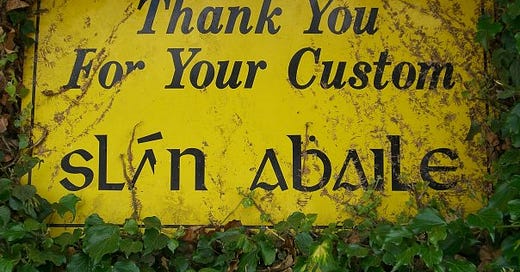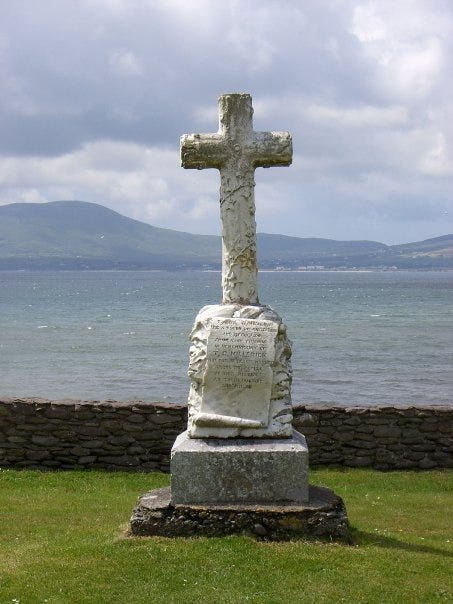Sinners Movie: Cultural Vampires, Irish History, and the Cost of White Supremacy
Before I begin, I want to acknowledge that the overall story of Sinners by Ryan Coogler is not mine to tell. I am approaching this reflection through my eyes as an Irish American, focusing on Remmick’s story. For those who want to deepen their understanding of the Mississippi Delta during the 1930s, I encourage you to explore the two resources from the Black community that I’ve linked below.
The Sinners Movie Syllabus by Jamar Tisha and Keisha N. Blain
https://www.aaihs.org/the-sinners-movie-syllabus/
Several days after seeing Sinners in the theatre with my husband, I could not stop thinking about the amount of symbolism that was woven into the story. I’m embarrassed to say that it took me nearly a week to realize why Ryan Coogler used vampires: they are symbolic cultural vampires. Remmick’s obsession with Sammie’s talents and a deep desperation to get inside the Juke.
When I first visited Ireland, I felt something stir in me, something deep and almost wordless. It was as though my soul already knew where it was. I felt a connection to the land, the people, my family, and the past. It was a sense of belonging I can’t fully explain.
I remember standing in this very spot, on the Ring of Kerry, with wind in my face. I took a deep breath, and it was the first time I felt that I belonged somewhere. So often throughout my life, I felt as though I couldn’t find my place in social groups. I’m either too much, not enough, or too opinionated. My dad had just passed away, and I was deeply grieving. But, for that brief moment, I belonged.
Here in the United States, I have also been on a journey of learning. I have peeled back the stories this country teaches us, especially about the Black community. Reading Revolutionary Suicide by Huey P. Newton was a turning point for me recently. It changed how I see this country and forced me to confront how much harm has been done, and continues to be done, by the systems we live under.
That is what drew me to Remmick’s story in Sinners. As an Irish American, I saw something familiar in his character. Here was someone shaped by a history of colonization, cultural theft, and displacement. Yet here was also someone who, in America, found safety in whiteness, even when that safety allowed him to harm others. Days after seeing the movie, I was still turning it over in my mind. The use of vampires was striking. It felt symbolic of cultural hunger, survival, and consumption. I wanted to explore how people shaped by oppression can become part of oppressive systems, and how shared histories do not always lead to solidarity.
Ireland’s Past: Loss, Survival, and Memory
Ireland’s story is not just one of rolling hills and folklore. It is a story of people stripped of language, culture, land, and voice. Long before Remmick appears on screen, his people were marked by centuries of harsh rule, much of it tied to Christianity.
When the English crown took hold of Ireland, it did not just bring soldiers. They brought laws meant to erase. The Penal Laws of the 1600s and 1700s banned Irish Catholics from owning land, voting, or going to school. Gaeilge, the native Irish language, was slowly forced out. Families learned English just to survive. Protestantism became the religion of power, while Catholicism was punished and pushed underground.
By the time the Great Famine, or what I prefer to call the Government Famine, hit in the 1840s, Ireland was already bleeding. Over a million people died, and another million fled, many to America. While Irish people starved, food was still being exported to England.
Even the famous Irish step dance is said to have been shaped by this oppression. Some believe the rigid, arms-at-sides style came from dancers hiding their movements from church officials watching through windows. Creativity became survival, and survival became an act of quiet rebellion.
The Double Edge of Faith and Power
For the Irish, Christianity was not just a faith. It was control. It was used to turn neighbors against each other, break up families, and demand obedience. It left behind a painful inheritance, a deep love for culture mixed with a deep grief over what had been stolen.
In Sinners, Remmick carries the weight of this. Near the end, just before he tries to kill Sammie, he recites a Bible verse. He says it is the same verse he heard when his father was murdered and their land was taken. Even with all that pain, it still brings him comfort. This moment shows how deeply the tools of oppression can bury themselves in the human heart. Something used as a weapon can also become a lifeline.
A Fragile Bridge: Black and Irish Struggles
Even though Remmick came from an oppressed background, when he arrived in America, he found something his people back home never had. He found safety in whiteness.
In Sinners, this comes through when Remmick runs to a KKK couple’s home, trying to escape the Choctaw Native Americans hunting him. The Native people warn the couple about the danger, but they choose to trust Remmick. Not because of his goodness, but because of his whiteness.
This reflects a larger truth. Irish immigrants, once mocked and marginalized in America, eventually found a way to rise by siding with white America. Over generations, many gained the benefits of being seen as fully white, even if that meant distancing themselves from Black and Native communities.
It is important to remember that Irish and Black Americans share deep histories of loss. Both faced stolen language, cultural erasure, displacement, and survival under brutal systems. There were real moments of solidarity, like when Frederick Douglass traveled to Ireland or when Irish nationalists aligned with anti-slavery movements. But this solidarity was often fragile. It was easily broken by the pull of power, the scramble for survival, or the lure of privilege.
Finding Refuge in Whiteness: A Hard Truth
Remmick’s story reminds us that suffering does not automatically create justice. The Irish came to America carrying their wounds. Over time, many found protection in the same systems that harmed Black and Native people. They gained refuge by stepping into whiteness and claiming the power it offered.
This is not just a story of the past. It echoes today. When we talk about oppression, healing, or solidarity, we must look at who holds power now and how that power is used.
For me, this is a reminder to keep learning, to keep asking hard questions, and to stay honest about where my own story fits in these systems. Recognizing past harm is not enough. We have to understand how harm continues and how we can help dismantle it.
What runs beneath Remmick’s story, and much of Irish immigrant history in America, is the hard truth of white supremacy. White supremacy is not just about personal hatred or individual prejudice. It is a system built to protect whiteness as power, to grant benefits to those who can access it, and to harm or exclude those who cannot.
In Sinners, we see how Remmick, an Irish man shaped by a history of oppression, is still able to take refuge in whiteness in America. He is believed over Native voices, sheltered by the KKK, and given space that Black and Native people are denied. His story reveals how white supremacy pulls people into its logic, offering protection in exchange for silence or participation.
White supremacy teaches people to hold tight to whatever power they can grab, even if it means turning against others who are hurting. It shapes how communities see themselves, choose alliances, and survive in a system rigged to divide and conquer.
Looking at this is part of the work of dismantling those systems. It means not just feeling sorrow for past harm, but recognizing how these systems are alive and active today, shaping the political climate, the policies we live under, and how people are treated across this country.
Lessons for Today’s World
We might think of Sinners or Remmick’s history as something distant, but they are tied together. We saw how in 100 days, museums in real time were almost completely pillaged, historical documents destroyed, and digital records deleted.
Today’s political climate shows us how easily systems turn people who have suffered against others who are struggling. We see how faith can be used as a weapon in political spaces, just as it was in Remmick’s life. We see how some communities are lifted by structures of power, while others are pushed aside, criminalized, or silenced.
These stories remind us that the work of protecting truth, building solidarity, and challenging the systems that divide us is far from over. They ask each of us to look honestly at where we come from, what histories we carry, and what choices we will make about the kind of world we want to help build. When the political and moral pendulum swings again, we need to question whether we want to go back to how this country operated before January of 2025. Or, will we ensure we create a country built on humanity and true equality? I know where I stand.





